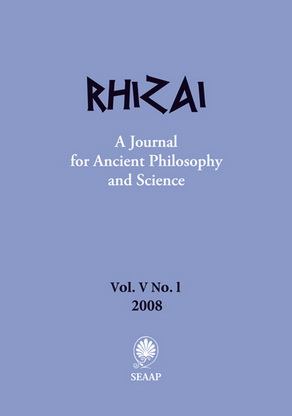Matters of Size, Texture, and Resilience: The Varieties of Elemental Forms in Plato’s Timaeus
Matters of Size, Texture, and Resilience: The Varieties of Elemental Forms in Plato’s Timaeus
Author(s): István BodnárSubject(s): Philosophy
Published by: Издателство »Изток-Запад«
Keywords: Plato; Timaeus; Form; structure; solid; ontology; cosmology; genesis; geometry; elements,
Summary/Abstract: Timaeus after assigning four regular solids – tetrahedra, octahedra, icosahedra and cubes – to fire, air, water and earth, respectively, submits at 57d–e that different kinds of gaseous, liquid or solid materials, and their interactions and intertransformations require that the four solids occur in different sizes. The paper discusses two different strategies for the generation of these differences in size: the traditional one, which allows that the triangles that are the fundamental building blocks of these solids do occur in different sizes, and the one proposed by Cornford, which suggests that triangles of exactly the same size may form different structures, and these can give rise to solids of different sizes. Considerations are drawn from descriptions of some specific interactions (which suggest that the differences of size may occur only within a rather narrow range, severely restricting the use of Cornford’s directions for the generation of an open ended series of different structures), from the account of sight (where I argue that the interactions which give rise to sight need not involve transformations between different fire corpuscles), and physiology (where I draw attention to the fact that the triangles are not perfect and unchangeable entities, indeed, the changes they undergo impair their capacity to form complex structures). All in all, these considerations seem to favour the traditional account. After this, in a final section I suggest that the specific claims Timaeus makes about the status of his account about the elements – certainty for the assignment of tetrahedra to fire, octahedra to air, and icosahedra to water, whereas the half-equilateral triangle as the fundamental building block of these solids is introduced in a tentative manner, explicitely stressing that this detail is revisable – makes it unsurprising that he does not discuss in detail how solids – and triangles and squares – of different sizes are constructed.
Journal: Rhizai. A Journal for Ancient Philosophy and Science
- Issue Year: V/2008
- Issue No: 1
- Page Range: 9-34
- Page Count: 26
- Language: English
- Content File-PDF

